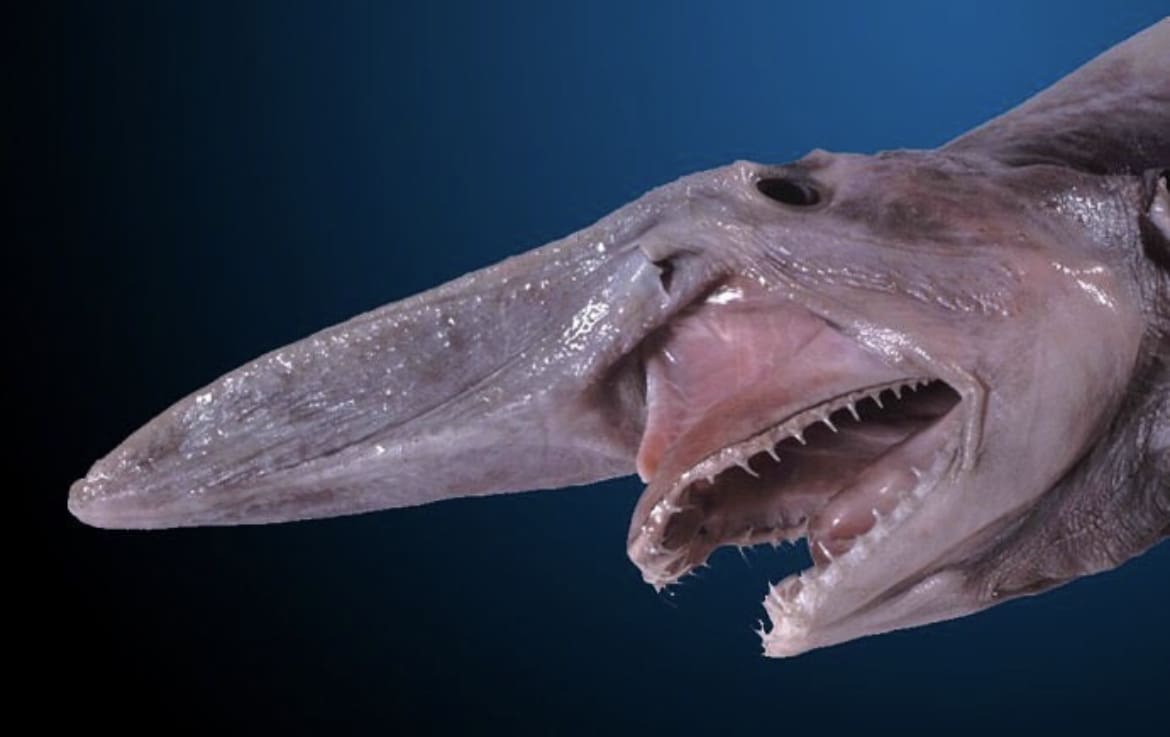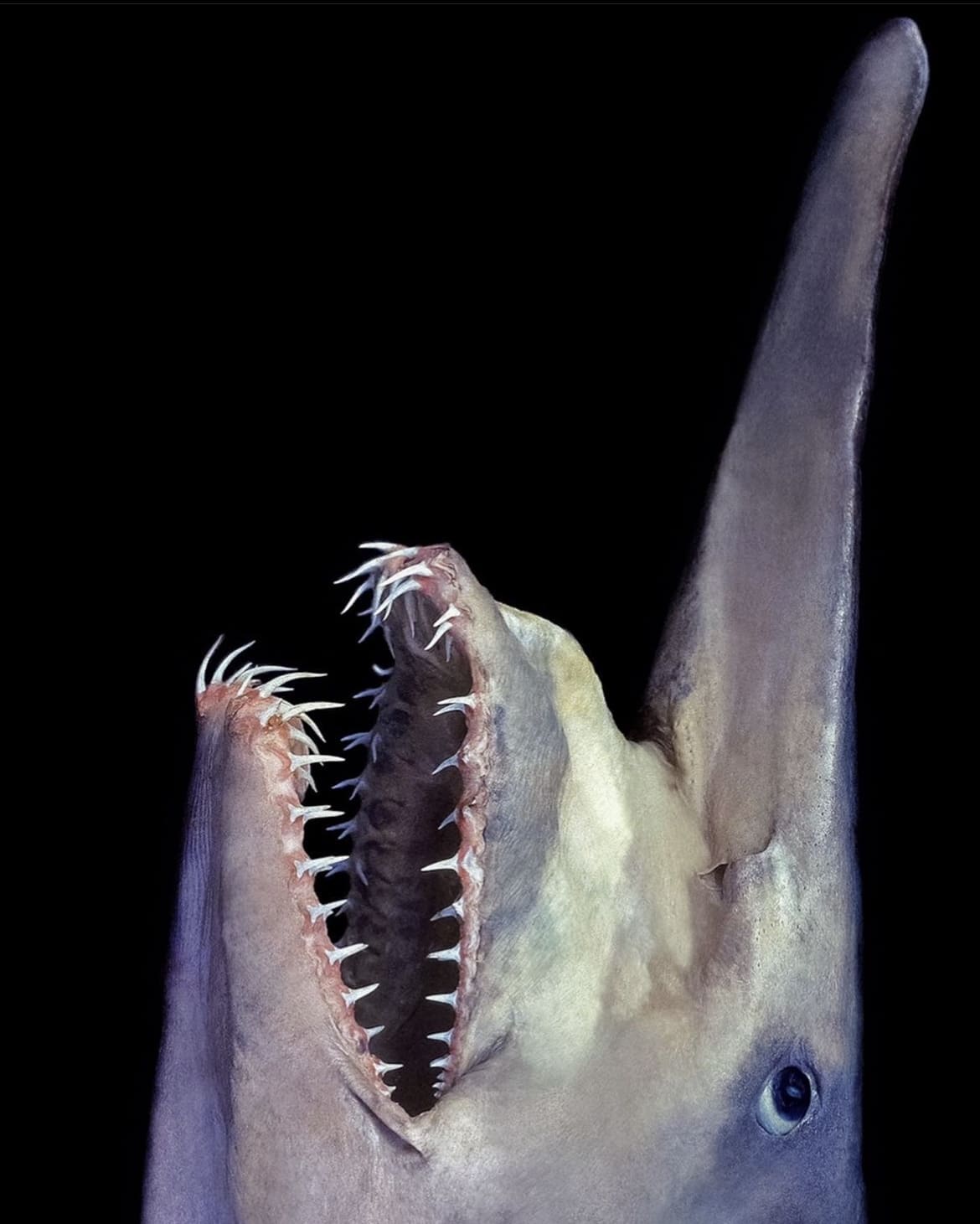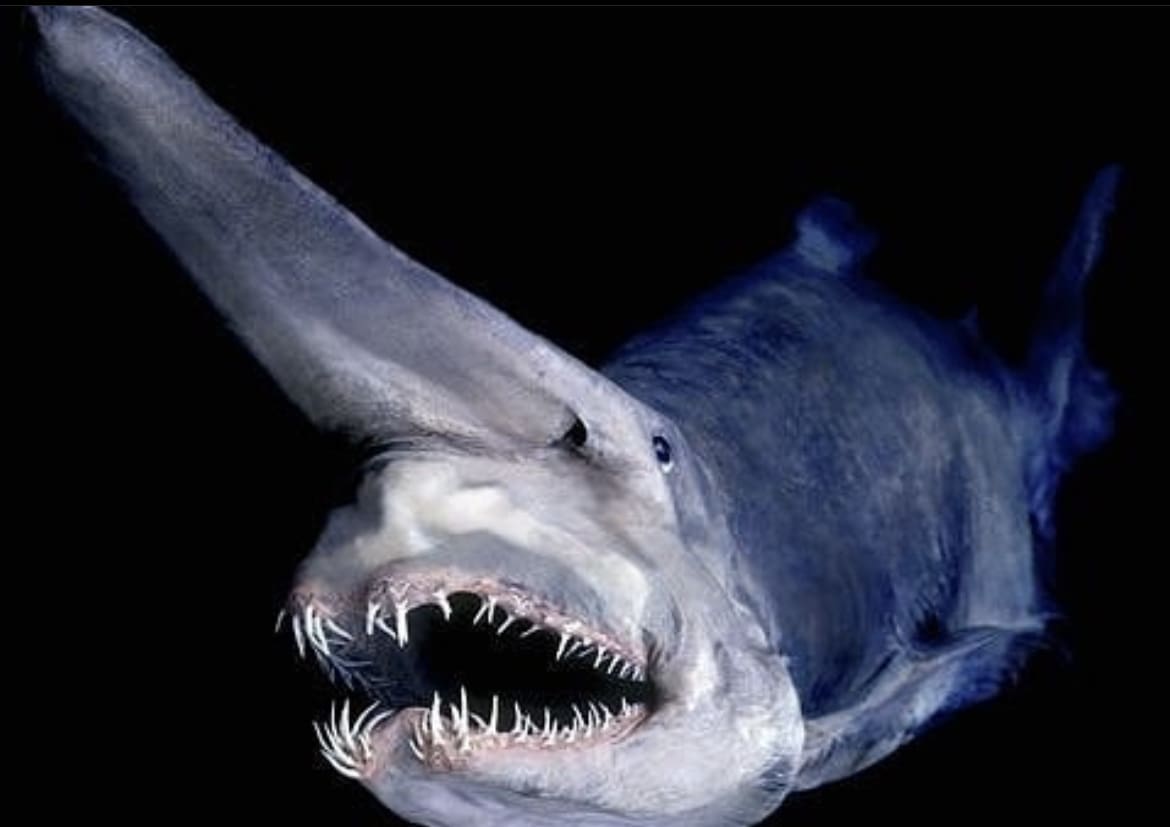Dive into the shadowy depths of the ocean with us as we unravel the mysteries of the Goblin Shark, a creature as elusive as it is fascinating. This journey through the dark waters will introduce you to one of the sea’s most ancient inhabitants, revealing the truths behind the myths and showcasing the unique adaptations that have allowed this “living fossil” to survive through the ages.
What is the Goblin Shark?
Picture this: a creature so bizarre and elusive that it’s often referred to as a “living fossil” from the depths of the ocean. That’s the Goblin Shark for you, folks. This deep-sea dweller is the stuff of marine legends, not just because it looks like it swam straight out of a prehistoric era, but also because sightings are as rare as finding a needle in a haystack—or, in this case, in the vast, unexplored waters of our oceans.
Belonging to the family Mitsukurinidae, the Goblin Shark stands out in the shark lineage for its distinctive appearance and ancient lineage. It’s like the ocean’s version of a hidden treasure, except this one has a lineage that traces back around 125 million years. Yeah, you heard that right. This shark has been around since the dinosaurs roamed the earth and has changed so little that scientists consider it a living window into the past.
What do Goblin Sharks look like?
Okay, let’s talk looks. The Goblin Shark isn’t winning any beauty contests, but what it lacks in looks, it makes up for in sheer uniqueness. Imagine a shark with a soft, flabby body and a protruding snout that looks like something out of a cartoon. This snout isn’t just for show; it’s packed with electrosensory organs that help the Goblin Shark detect its prey in the dark depths of the ocean.
But the real showstopper is its jaw. Unlike your standard shark, the Goblin Shark’s jaw can shoot out like a science fiction monster to snag unsuspecting prey. Its mouth is lined with needle-like teeth perfect for gripping slippery fish and squid. And those eyes? Small, beady, and almost too creepy, they’re adapted to the twilight zone of the deep sea, where light is scarce.
How big are Goblin Sharks?
When it comes to size, the Goblin Shark tends to keep things on the down-low. Juveniles are rarely seen, and the adults that have been caught or observed range from about 3 to 4 meters (10 to 13 feet) in length. However, there are tales of these sharks reaching lengths of up to 6 meters (nearly 20 feet)! That’s about as long as a school bus. But don’t let their size intimidate you; these sharks are deep-sea roamers, living in environments so remote and inaccessible that you’re unlikely ever to encounter one during a casual swim or dive.
Goblin Shark Skin
When it comes to skin, the Goblin Shark throws us another curveball. Its hide is not the sleek, streamlined affair you might expect from a predator of the deep. Instead, it’s flabby and loose, a far cry from the athletic builds of its shark cousins closer to the surface. This unique skin texture plays a crucial role in its deep-sea lifestyle, allowing for efficient movement in a habitat where energy conservation is key. Plus, its skin is a pale, pinkish color, thanks to the visible blood vessels underneath—a ghostly appearance that adds to its otherworldly vibe.
Goblin Shark Teeth
Now, let’s talk about one of the Goblin Shark’s most fascinating features: its teeth. These aren’t your typical shark teeth; they’re long, slender, and eerily translucent, designed to trap rather than slice. The Goblin Shark’s dental arrangement is a mixed bag of nail-like teeth in the front and slightly flatter, sharper teeth at the back. This setup suggests a diet that requires gripping and snagging rather than tearing and cutting—perfect for the soft-bodied squids and fish that make up its meals.
Goblin Shark Colouration
Diving deeper into the Goblin Shark’s appearance, its coloration is a ghostly spectacle. The pinkish hue, a result of its semi-transparent skin showing the blood vessels underneath, gives it an almost ethereal presence in the deep blue.
This pale coloration is thought to serve as camouflage in its deep, dark habitat, blending into the sparse light and shadows of the ocean depths. It’s a master of disguise, using its body not just as a hunting tool but as a cloak to navigate the unseen world it calls home.
What do Goblin Sharks eat?
The diet of the Goblin Shark is as mysterious as its appearance. These sharks are not your typical apex predators; they’re more like the scavengers of the deep, feasting on whatever the ocean floor offers.
Their menu mainly consists of deep-sea fish, squids, and crustaceans. The Goblin Shark’s method of feeding is particularly fascinating. It uses that bizarre, protruding jaw to snap forward and catch prey in a sudden, surprise attack. This ambush strategy, coupled with their ability to sense electric fields produced by potential meals, makes them formidable hunters in their shadowy realm.
How do Goblin Sharks hunt?
Goblin Sharks are the ninjas of the deep sea. Their hunting technique is as unique as their appearance. Instead of relying on speed or brute force, they utilize stealth and their highly specialized jaw. This jaw, capable of rapid projection, allows the Goblin Shark to extend its bite in the blink of an eye, snatching prey before it even knows what hit it.
Coupled with their ability to detect the faint electric fields generated by other sea creatures, the Goblin Shark’s hunting strategy is perfectly adapted to the deep-sea environment, where visibility is low, and stealth is key to survival.

Goblin Shark Social Structure
If the Goblin Shark’s social life were a Facebook status, it would definitely be “It’s complicated.” These creatures are the loners of the deep sea, seldom seen together and leading a largely solitary existence. Unlike some shark species that form schools or hunting packs, Goblin Sharks seem to prefer their own company.
This solitary nature likely stems from their deep-sea habitat, where the vast, sparse environment makes encounters between individuals rare. So, if you’re imagining underwater gatherings of Goblin Sharks, think again. These sharks are all about that solo lifestyle.
How do Goblin Sharks reproduce?
The reproductive habits of the Goblin Shark are, to put it mildly, a bit of a puzzle. What little we know comes from the rare occasions when pregnant females have been caught. Like many deep-sea creatures, Goblin Sharks are ovoviviparous, meaning their eggs hatch inside the female’s body, and she gives birth to live young. However, details on mating rituals, gestation periods, and nursery grounds remain elusive.
The deep sea doesn’t give up its secrets easily, and the Goblin Shark’s reproductive life is no exception. We know they’re out there, continuing their ancient lineage in the abyss, but the specifics remain one of the ocean’s many mysteries.
How long do Goblin Sharks live?
Estimating the lifespan of a creature as elusive as the Goblin Shark is like trying to solve a puzzle with half the pieces missing. However, based on what we know about other deep-sea shark species, scientists speculate that these ghostly predators could live for decades, possibly up to a century.
The deep sea is a harsh environment, but it also lacks the rapid changes and predators found in shallower waters, potentially allowing its inhabitants to enjoy longer lives. Yet, without direct observations or studies, the exact lifespan of the Goblin Shark remains an educated guess.

Are Goblin Sharks aggressive?
Despite their somewhat nightmarish appearance, Goblin Sharks are not the monsters of the deep they may seem to be. There’s little evidence to suggest they’re aggressive towards humans.
In fact, considering their deep-sea habitat, human encounters with these sharks are incredibly rare. When they do occur, it’s usually because a Goblin Shark has been inadvertently caught in deep-sea fishing nets. These encounters show that while the Goblin Shark might look like something out of a horror movie, it’s far from a bloodthirsty beast. They’re adapted to a life of quiet predation in the deep, far removed from human activity.
Are Goblin Sharks territorial?
Given the vast and sparsely populated expanses of the deep sea, the concept of territoriality among Goblin Sharks remains an open question.
The sheer depth and breadth of their habitat make encounters between individuals rare, suggesting that territorial disputes are likely uncommon. Unlike their shallow-water cousins, which may patrol fixed territories, Goblin Sharks roam the ocean depths in search of food, their nomadic lifestyle dictated by the availability of prey rather than the defense of a particular area.
This elusive behavior underscores the adaptability required to survive in the deep sea, where resources are scarce and widely dispersed.
Where do Goblin Sharks live?
Goblin Sharks are the phantoms of the deep, residing in the twilight zone of the ocean, where light fades to darkness. They’re found in deep-sea environments worldwide, from the Gulf of Mexico to the waters off Japan, Australia, and even the Atlantic Ocean.
Depths of 270 to 960 meters (890 to 3,150 feet) are their usual haunts, but they’ve been known to dive deeper, beyond 1,300 meters (4,265 feet), in search of prey. This wide range of habitat speaks to the Goblin Shark’s adaptability and the mystery that surrounds its lifestyle, as it navigates the world’s most remote and unexplored ecosystems.
How many Goblin Sharks are there in the wild?
Quantifying the population of Goblin Sharks is akin to counting shadows in the dark. Their elusive nature, combined with the inaccessibility of their deep-sea habitat, makes accurate population assessments nearly impossible.
Sightings and captures are rare, often occurring incidentally through deep-sea fishing operations. As a result, the International Union for Conservation of Nature (IUCN) has classified the Goblin Shark as “Least Concern,” not due to an abundance of individuals but rather due to a lack of data indicating they are under threat. This status may change as we learn more about their numbers and the impacts of human activities on their deep-sea environment.
Are Goblin Sharks endangered?
Currently, the Goblin Shark is not considered endangered. Classified as “Least Concern” by the IUCN, there’s little direct evidence to suggest that they’re facing imminent threats to their survival.
However, this classification is largely due to the scarcity of data on their population and distribution. The deep-sea habitats of Goblin Sharks protect them from many human activities, but they’re not immune to the broader environmental impacts, such as climate change, pollution, and deep-sea trawling, that could affect their food sources and living conditions.
As such, while not currently endangered, the Goblin Shark’s long-term survival is intertwined with the health of the deep-sea ecosystems it inhabits.
Threats to Goblin Sharks in the wild
The Goblin Shark’s existence is threatened by a variety of factors, most of which are indirect consequences of human activity. Deep-sea fishing, especially trawling, poses a risk, as these sharks can be caught as bycatch, an unintended catch that often results in death. Additionally, the deep sea is not immune to the impacts of climate change, which could alter the temperature and chemistry of their habitat, affecting both the sharks and their prey.
Pollution, in the form of plastic and chemical contaminants, also reaches the ocean’s depths, posing another set of challenges for deep-sea life. While Goblin Sharks are somewhat shielded by their remote habitat, these environmental pressures highlight the need for ongoing research and conservation efforts to ensure their survival in the face of changing global conditions.
Can You Dive with Goblin Sharks?
The prospect of diving with Goblin Sharks might sound like an adventure straight out of a deep-sea explorer’s dream. However, given their preference for the ocean’s twilight zone, such encounters are exceedingly rare and not feasible for recreational divers.
The depths at which Goblin Sharks reside are far beyond the reach of standard scuba gear, requiring specialized equipment and submarines. While the thrill of seeing a Goblin Shark up close remains a tantalizing fantasy, for now, it remains just that—a fantasy. The deep, mysterious world of the Goblin Shark is one that few humans will ever witness firsthand.
Tips for Spotting Goblin Sharks
For those dedicated souls who dream of spotting a Goblin Shark, the task is daunting but not entirely without hope. Your best bet is to get involved with deep-sea research expeditions or follow the findings of marine biologists who explore the ocean’s depths.
Modern technology, such as remotely operated vehicles (ROVs) and deep-sea submersibles, offers a window into the Goblin Shark’s world, albeit from the safety of a research vessel. Keeping an eye on scientific journals and marine news can also alert you to any new sightings or discoveries. While the chances of seeing a Goblin Shark in the wild are slim, the pursuit of knowledge about these deep-sea phantoms is a worthy adventure in itself.
Facts about The Goblin Shark
- Living Fossil: The Goblin Shark is often referred to as a “living fossil” because its lineage dates back about 125 million years.
- Jaw Mechanics: Its jaw can protrude almost to the length of its snout to snatch prey, a unique feature among sharks.
- Deep-Sea Habitat: Goblin Sharks live in waters as deep as 1,300 meters (4,265 feet), primarily along continental shelves and submarine canyons.
- Rare Sightings: Due to their deep-sea habitat, Goblin Shark encounters with humans are extremely rare, making every sighting a significant event.
- Pink Skin: The shark’s pinkish hue comes from blood vessels close to the thin skin, giving it an almost translucent appearance.
- Global Distribution: While elusive, Goblin Sharks have a worldwide distribution, found in deep seas around Japan, the Gulf of Mexico, and even the Atlantic.
Myths about The Goblin Shark
- Monster of the Deep: Despite its eerie appearance, the Goblin Shark poses no known threat to humans, debunking any myths of it being a man-eater.
- Giant Predator: While large, Goblin Sharks are not the giants of the sea many imagine. Most adults measure around 3 to 4 meters (10 to 13 feet).
- Aggressive Nature: There’s no evidence to suggest Goblin Sharks are any more aggressive than other shark species; their deep-sea lifestyle makes human encounters nearly impossible.
- Common Sightings: The myth that Goblin Sharks are commonly encountered by deep-sea divers is false, given their rare sightings and deep-sea habitat.
The Goblin Shark remains one of the ocean’s most fascinating mysteries, a reminder of the wonders that lie hidden in the deep. As we continue to explore these uncharted territories, perhaps we will uncover more secrets of these ancient creatures. But for now, the Goblin Shark remains a ghostly presence in the deep, a symbol of the ocean’s vast and unexplored mysteries.
Through our continued efforts in research and conservation, we hope to ensure that the Goblin Shark, and countless other deep-sea species, can thrive for generations to come, safeguarding the biodiversity of our planet’s final frontier.


